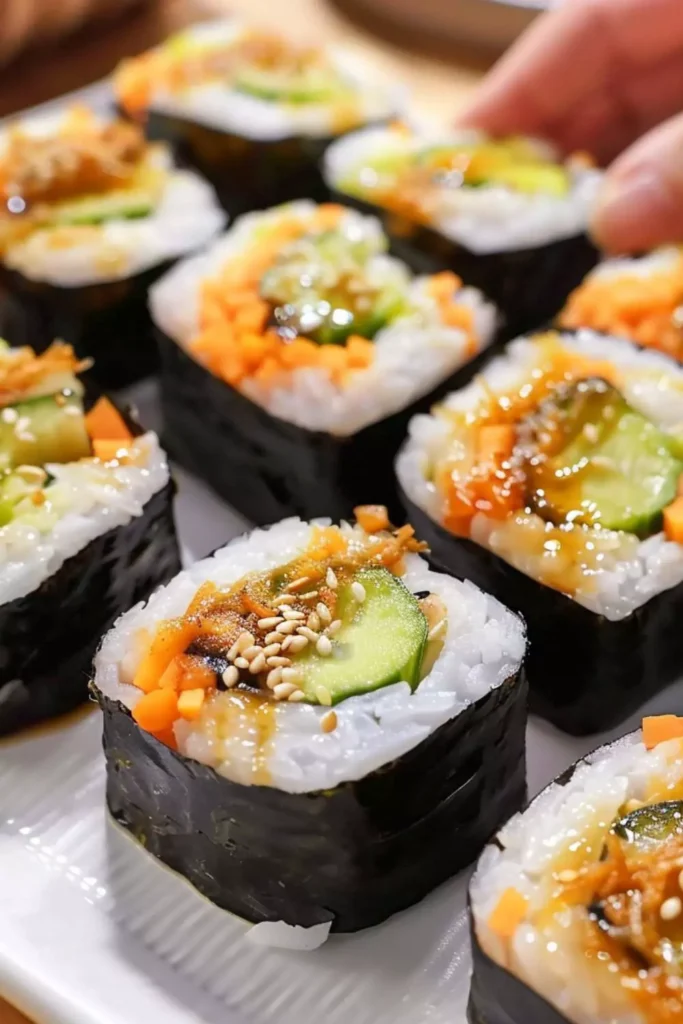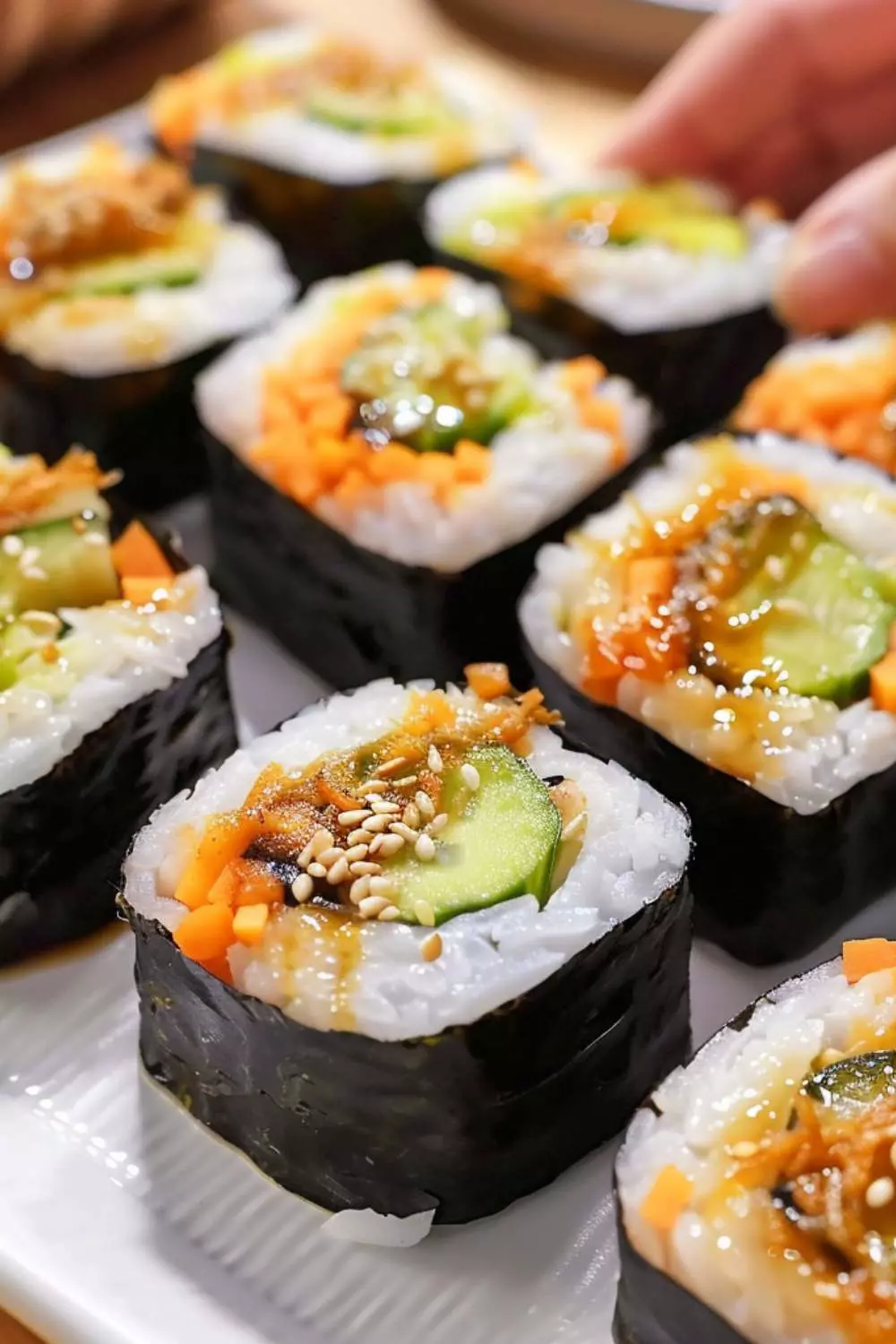Picture this: a delightful blend of fresh vegetables, succulent seafood, and aromatic sushi rice encased in a delicate, translucent rice paper wrapper.
That’s the magic of rice paper sushi rolls – a culinary creation that captivates not only the taste buds but also the eyes. In this article, I will take you on a journey to explore the wonders of rice paper sushi rolls, from its origins to the step-by-step process of creating this delectable dish.
Join me as we unravel the secret to making this delicious and visually stunning treat that will surely impress your family and friends.

What is rice paper sushi roll?
Rice paper sushi rolls, also known as “summer rolls” or “Vietnamese fresh rolls,” are a type of sushi roll that does not require traditional seaweed wrappers.
Instead, they are wrapped in thin, translucent rice paper sheets, which give them a light and refreshing taste. The rice paper adds a delicate texture to the rolls, allowing the colorful fillings to shine through.
What is the flavor profile of this dish?
The flavor profile of rice paper sushi rolls is a delightful combination of freshness, crunchiness, and umami richness. The sweet and tangy sushi rice provides a perfect balance to the savory fillings, such as fresh vegetables, creamy avocado, and succulent seafood. The delicate rice paper wrapper adds a light and refreshing touch, making each bite a burst of flavors and textures.
You’ll also like the following Appetizer recipes!
Why You’ll Love this?
There are countless reasons why you’ll fall in love with rice paper sushi rolls.
Firstly, they are incredibly versatile – you can customize the fillings to suit your preferences, whether you’re a seafood lover, a vegetarian, or a meat enthusiast.
Secondly, they are a healthier alternative to traditional sushi rolls, as they are not fried and contain fresh, wholesome ingredients.
Lastly, the visual appeal of rice paper sushi rolls is hard to beat – they make for a stunning presentation on any dining table, perfect for impressing guests or elevating your home dining experience.
Ingredients:
Carrot:
I incorporate fresh carrots for a crisp and vibrant crunch, adding both texture and color to the rice paper sushi rolls.
Nori Cut:
The nori cut brings a subtle taste of the sea, enhancing the overall flavor profile of the sushi rolls.
Avocado:
Creamy avocado is a key ingredient, contributing a smooth and luscious texture to each bite of the rice paper sushi rolls.
Rice Paper:
The essential wrapping element, rice paper, brings everything together, creating the perfect vessel for a delightful sushi experience.
English Cucumber:
The addition of English cucumber provides a refreshing and hydrating element, balancing the flavors in the rice paper sushi rolls.
Filling:
Kewpie Mayo & Imitation Crab:
Kewpie mayo in the filling adds a creamy richness, complementing the savory strips of imitation crab for a delicious combination.
Sushi Rice:
I incorporate 3 cups of perfectly cooked sushi rice as the fundamental base for my rice paper sushi rolls.
Rice Vinegar:
Adding 2 tbsp of rice vinegar enhances the sushi rice, contributing a delightful hint of acidity that complements the overall flavor profile.
Salt:
A quarter teaspoon of salt is carefully added to the sushi rice, elevating its taste and creating a well-balanced foundation for the rolls.
Granulated Sugar:
To achieve the desired sweetness, I include 1 tsp of granulated sugar, ensuring the sushi rice offers a harmonious blend of flavors.
This meticulous seasoning process transforms the sushi rice into a flavorful and cohesive element, providing the perfect backdrop for the other ingredients in my rice paper sushi roll recipe.

Step by Step Instructions:
Step 1: Prepare Rice Paper
Gently dip the rice paper in room temperature water for about 10 seconds.
Carefully place the moistened rice paper onto a dry surface.
Step 2: Arrange Nori and Rice
In the center of the rice paper, lay a piece of nori.
Spread 2 tbsp of sushi rice evenly, molding it into a neat 3 by 2-inch rectangle.
Step 3: Layer Ingredients
Add a flavorful layer with 1 tbsp of Kewpie mayo-infused imitation crab strips.
Place 8 cucumber strips and 3 slices of creamy avocado on top.
Step 4: Rolling the Sushi
Lift the bottom portion of the rice paper and gently fold it upward.
Fold the right side over to the left and then the left side over to the right.
Continue rolling, ensuring to tuck in any protruding filling.
Step 5: Finishing Touch
Enhance the visual appeal by sprinkling a pinch of roasted sesame seeds in the center of the rolled sushi.
For Crispy Texture:
Step 1: Shallow Frying
In a nonstick pan, heat 1 mm of vegetable oil over medium-high heat.
Shallow fry the rice paper sushi rolls for approximately 30 seconds per side.
Step 2: Cooling
Transfer the freshly fried rolls to a wire rack to cool, allowing them to achieve a delightful crispness.
Step 3: Serve with Sriracha Aioli
Present the crispy rice paper sushi rolls immediately.
Enjoy the delectable combination with a side of Sriracha Aioli for that extra kick.
Tips & Tricks:
– Soak the rice paper in warm water for just a few seconds to prevent it from becoming too soft and sticky.
– Use a damp kitchen towel to prevent the rice paper from sticking to the work surface.
– Customize the fillings to your liking – feel free to add shrimp, fresh herbs, or thinly sliced vegetables.
– To prevent the rice paper sushi rolls from drying out, cover them with a damp paper towel before serving.
– Experiment with different dipping sauces, such as spicy mayo or peanut sauce, to elevate the flavors of the rolls.

Nutrition Information:
– Serving Size: 1 roll
– Sodium: 260 mg
– Total Fat: 8 g
– Calories: 270
– Protein: 4 g
– Saturated Fat: 2 g
– Trans Fat: 0 g
– Cholesterol: 10 mg
– Sugars: 5 g
– Total Carbohydrates: 45 g
– Dietary Fiber: 3 g
How Can You Store This rice paper sushi roll?
To store rice paper sushi rolls, place them in an airtight container and refrigerate for up to 24 hours. To prevent them from sticking together, separate the rolls with parchment paper or plastic wrap. Before serving, bring the rolls to room temperature and enjoy them fresh.
If some of the ingredients are not available in your pantry, what are some alternative choices you can consider?
If you’re missing some of the ingredients for rice paper sushi rolls, here are some alternative choices you can consider:
– Carrot: Substitute with bell peppers or pickled radish for a similar crunch.
– Avocado: Replace with mango or sliced cucumber for a different flavor profile.
– Imitation crab: Use cooked shrimp, smoked salmon, or tofu as protein alternatives.

Equipment
- measuring cups, and spoons
- Spoons and Forks
- strainer
- Spatula
- Wooden spoon
- Mixing bowl
- Large pot
- Frying pan
- knife
- cutting board
Ingredients
- 1 Large Carrot peeled
- 1 sheet nori cut into 4 by 3 cm pieces
- 1 whole avocado sliced
- 6 sheets rice paper small
- ⅓ piece English cucumber julienned
- 3 tbsp Kewpie mayo
- 1 cup imitation crab pulled into strips
- 2 tbsp rice vinegar
- ¼ tsp salt
- 3 cups sushi rice cooked
- 1 tsp granulated sugar
Instructions
- Gently dip the rice paper in room temperature water for about 10 seconds.
- Carefully place the moistened rice paper onto a dry surface.
- In the center of the rice paper, lay a piece of nori.
- Spread 2 tbsp of sushi rice evenly, molding it into a neat 3 by 2-inch rectangle.
- Add a flavorful layer with 1 tbsp of Kewpie mayo-infused imitation crab strips.
- Place 8 cucumber strips and 3 slices of creamy avocado on top.
- Lift the bottom portion of the rice paper and gently fold it upward.
- Fold the right side over to the left and then the left side over to the right.
- Continue rolling, ensuring to tuck in any protruding filling.
- Enhance the visual appeal by sprinkling a pinch of roasted sesame seeds in the center of the rolled sushi.
- In a nonstick pan, heat 1 mm of vegetable oil over medium-high heat.
- Shallow fry the rice paper sushi rolls for approximately 30 seconds per side.
- Transfer the freshly fried rolls to a wire rack to cool, allowing them to achieve a delightful crispness.
- Present the crispy rice paper sushi rolls immediately.
- Enjoy the delectable combination with a side of Sriracha Aioli for that extra kick.
Notes
- Soak the rice paper in warm water for just a few seconds to prevent it from becoming too soft and sticky.
- Use a damp kitchen towel to prevent the rice paper from sticking to the work surface.
- Customize the fillings to your liking – feel free to add shrimp, fresh herbs, or thinly sliced vegetables.
- To prevent the rice paper sushi rolls from drying out, cover them with a damp paper towel before serving.
- Experiment with different dipping sauces, such as spicy mayo or peanut sauce, to elevate the flavors of the rolls.
Nutrition
Frequently Asked Questions:
1. Can I make rice paper sushi rolls ahead of time?
Yes, you can prepare rice paper sushi rolls ahead of time and store them in the refrigerator for a few hours before serving. To maintain their freshness, cover the rolls tightly with plastic wrap or damp paper towels.
2. Can I freeze rice paper sushi rolls?
It is not recommended to freeze rice paper sushi rolls, as the rice paper can become soggy and lose its texture when thawed. It is best to enjoy them fresh for the best taste and quality.
3. Can I make vegetarian rice paper sushi rolls?
Absolutely! You can customize rice paper sushi rolls with a variety of vegetarian fillings, such as tofu, bell peppers, mushrooms, and leafy greens. Get creative with your choices to create a delicious vegetarian version of this dish.
4. What is the difference between rice paper sushi rolls and traditional sushi rolls?
The main difference between rice paper sushi rolls and traditional sushi rolls lies in the wrapper used. Rice paper sushi rolls are wrapped in translucent rice paper, while traditional sushi rolls are wrapped in seaweed sheets (nori). Rice paper sushi rolls also tend to have a lighter and fresher taste compared to their seaweed-wrapped counterparts.
5. Can I use regular rice instead of sushi rice for this recipe?
While sushi rice is traditionally used for making rice paper sushi rolls due to its sticky texture and mild flavor, you can use regular rice as a substitute in a pinch. Keep in mind that the texture and taste may vary slightly, but it will still work well as a base for the rolls.
Conclusion:
In conclusion, rice paper sushi rolls are a delightful treat that brings together the vibrant flavors of fresh ingredients with the elegance of translucent rice paper.
Whether you’re a sushi enthusiast looking to try something new or a home cook eager to impress with a visually stunning dish, rice paper sushi rolls are sure to satisfy your cravings. With a little creativity and a few simple steps, you can create your own masterpiece that will impress your taste buds and dazzle your guests.
So, why not embark on this culinary adventure and experience the joy of making and savoring these delightful rice paper sushi rolls today?
You’ll also like these latest recipes!

Rebecca Novak is a trained chef with over 10 years of experience in the food industry. She has worked in both fine dining and casual Hungarian restaurants and specializes in creating dishes using fresh, seasonal ingredients. She also loves exploring different cuisines worldwide, which allows her to bring unique flavors and ideas to the recipes she creates for Hungarianchef.com. Read more
